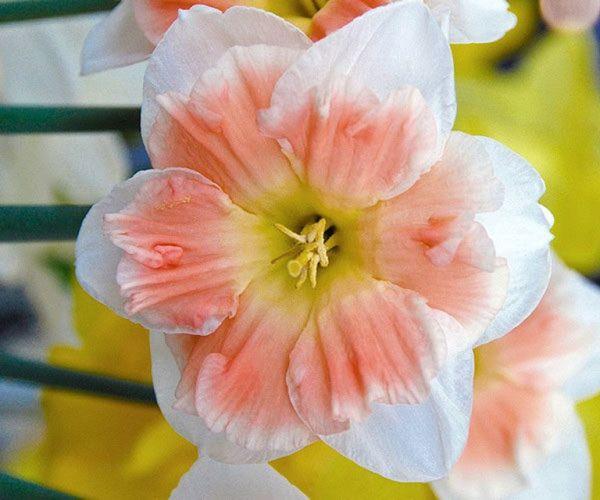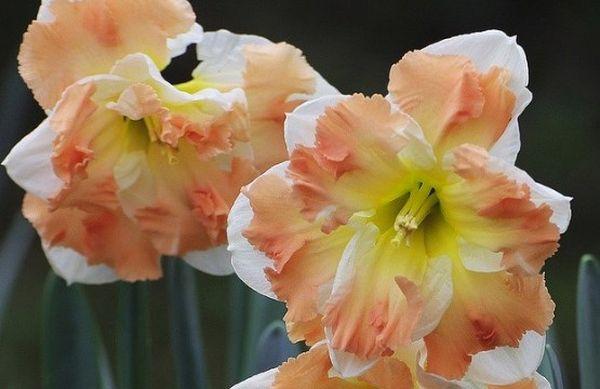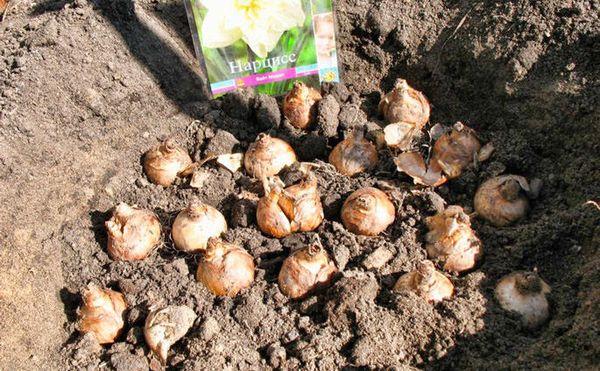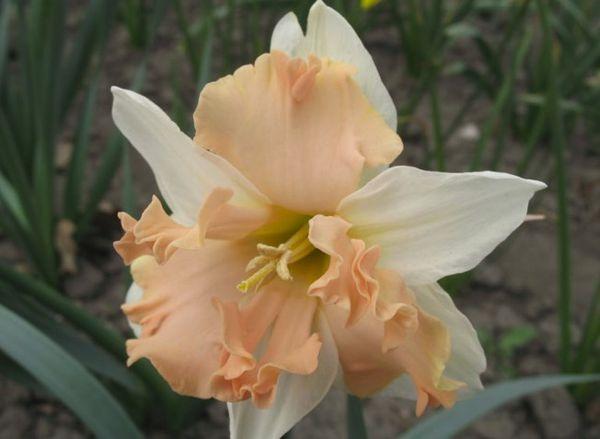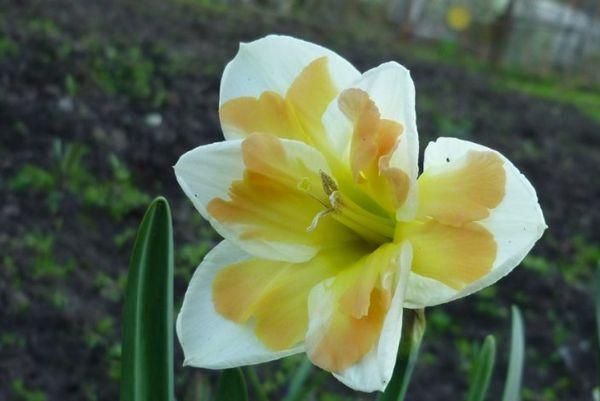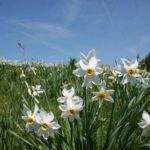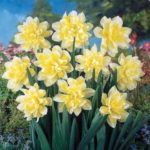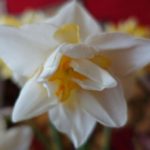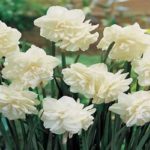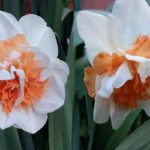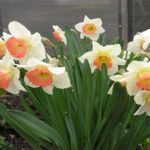The daffodil is a beautiful, elegant flower that creates an exotic atmosphere in any garden. It is not difficult to grow, observing agricultural standards. Narcissus variety Kum Laud is translated from Latin as “difference” and is popular in the CIS countries. To successfully grow the plant, you should familiarize yourself with the information below.
- Description and characteristics of the narcissus variety
- History of cum laude selection
- Growing
- Planting dates for narcissus Kum Laud
- Soil preparation
- Selection and storage of planting material
- Narcissus planting scheme
- Rules of care
- Loosening and weeding of the narcissus Kum Laud
- Watering
- Protection from pests and diseases
- Top dressing
- Reproduction
- Application in landscape design
- Reviews about narcissus
Description and characteristics of the narcissus variety
This is a perennial bulbous plant. The Cam Laud variety of daffodils is famous for its cream petals and wide apricot perianth lobes, edged with an orange split crown. Pollen falls in April, lasts 2-3 weeks, during which the color changes. The plant is tall, large, with green basal foliage. The height of the flower is about 35 cm, the diameter of the buds is 8-9 cm. Frost resistance is average, withstands winters with frosts down to -10.
History of cum laude selection
Narcissus Kum Laud is a variety of Dutch selection, known since 1975. The variety has gained popularity in the CIS countries since the 1990s. The flower can be grown in southern, middle latitudes. If we are talking about the north, it is kept in greenhouses.
Growing
Narcissus prefers sunny or slightly shaded places, without dampness or drafts. In the shade, flowers will bloom for a shorter time, and immunity may weaken.
Planting dates for narcissus Kum Laud
It is preferable to plant daffodils from August to October, when there is no frost yet. If we are talking about planting in greenhouse conditions, work can be carried out at any time of the year. If the deadlines are met, the daffodils will have time to take root before frost arrives.
Soil preparation
The land should be well drained and fertile. The soil is prepared in June by plowing. Organic compounds are added to it. Manure can be applied 1 year before planting. 2 weeks before planting, the soil is plowed again.
Selection and storage of planting material
You should buy seedlings from trusted sellers on the market or in flower shops with a good reputation. In spring, bulb seedlings are sold at large discounts due to staleness.
When choosing planting material, pay attention to the following aspects:
- integrity of rotten areas;
- the diameter of the bulb should be 5 cm;
- Choose a seedling that is hard and strong.
Before planting, inspect and discard damaged, weathered specimens. Healthy seedlings are disinfected with fungicides or a 1% solution of potassium permanganate.
Experienced gardeners recommend purchasing seedling material 3 months after the end of daffodil pollen in the country's gardens.
Narcissus planting scheme
The prepared bulbs are planted in open ground, they take root within a month. The depth of the holes should be 15-20 cm at a distance of 10-12 cm from the seedlings. After planting, the ground is mulched with straw.
Rules of care
Standard care is required, which includes timely watering, fertilizing, and treatment against pests and beetles. The longevity and pollen period of plants depend on the quality of fulfillment of the above tasks.
Loosening and weeding of the narcissus Kum Laud
During dry periods, from the end of spring, it is often necessary to loosen the soil around the daffodils. Weed the ground with a spade to the floor so as not to damage the rhizomes. The procedure improves soil aeration and removes weeds during the process.
Watering
Daffodils should be watered generously during flowering and for 4-5 weeks after. Then the bulbs accumulate a large number of useful components. For 1 square meter of plot you will need 20 liters of water. When the area has not been mulched, carefully weed the beds after each irrigation.
Protection from pests and diseases
Daffodils are sometimes affected by fusarium, rot, daffodil fly, tuberculate and onion hoverflies, mites, slugs, and nematodes.As a preventive measure, plants are treated with insecticides 2 times during the growing season. The first procedure occurs before the formation of buds.
Upon completion of pollen, spray the crop with a solution of copper sulfate in a ratio of 100 g per 10 liters of water, using 2 liters of working fluid per 10 square meters. You can also use the “HOM” product in the same dosage, prepared by diluting 40 g in 10 liters of water.
Top dressing
When cultivated in the garden, daffodils should be fertilized 2 times during the growing season. Mineral compounds are added during budding, 5 liters of solution per 1 square meter is taken. Superphosphate, potassium sulfate, urea are diluted in 10 liters; each substance is taken on 1 dessert spoon.
During flowering, add nitrogen, phosphorus and potassium, dilute 2 tsp in 10 liters of water. "Agricola", 1 tbsp. nitroammofoski. In the rain, liquid fertilizers are replaced with a one-time application of dry ingredients in March - per 1 square meter, 1 dessert spoon of potassium sulfate, urea, superphosphate and 1 tbsp. wood ash.
Reproduction
Daffodils are propagated by bulbs, children, or grown from seeds. For sowing, freshly harvested seed material that is not completely dry is used. Seeds should be collected in July or November. You can sow them in containers or bowls, if desired, in the garden. Sow sparsely, the depth should be equal to 3 seed diameters.
During the first 1-2 years, it is not advisable to pick or replant the seedlings, since they must form a strong bulb. When this happens, the young flowers are moved to a permanent place in the garden. The first pollen is observed after 6-7 years.
Application in landscape design
The variety is considered an early bloomer and is widely used for landscaping gardens, flower beds, and ridges. It is often planted between bushes of other plants. Daffodils look harmonious with violets, aster flowers, and roses in dark shades.
Reviews about narcissus
Feedback from gardeners about the Kum Laud narcissus is mostly positive. They will help you decide on the choice of variety.
Ignat Terentyev, 68 years old, Kyiv.
Hello! I have been growing the narcissus Kum Laud in my garden since 2009, the pollen is abundant and always pleasing to the eye. Caring for flowers is easy. I live in a private house, our winters are cold, sometimes I cover the plantings with mulch.
Victoria Ponomareva, 72 years old, Kropyvnytskyi.
Greetings! There are only positive reviews about the narcissus Kum Laud, a beautiful flower of a soft cream color. I learned about it from a neighbor in the country. Planted by seedlings in the garden. I fertilize periodically and treat with fungicides.

